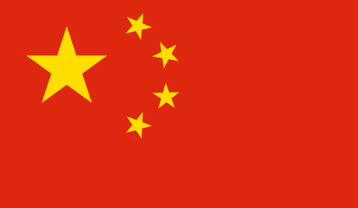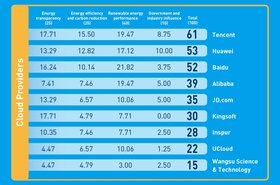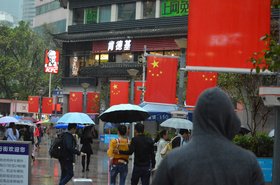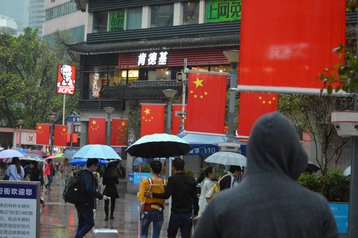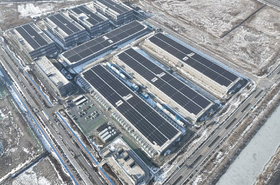As one of the largest and most powerful economies in the world, China’s areas of focus should be of interest to companies globally.
In its latest Five Year Plan, the Chinese Government has outlined a number of priority areas that could have an impact on both the domestic and global landscape with regards to data centers, semiconductors, and related infrastructure.
What is in China’s 14th Plan?
Based on a practice adopted from the Soviet Union, the Chinese Communist Party (CCP) regularly releases new economic plans every five years. The latest (14th) Plan runs from 2021 to 2025. Amongst other longer-term goals, it aims to make China a "moderately developed" economy by 2035.
The 14th Plan doesn’t have policies or objectives specifically for data centers – though there is a separate policy document for the sector which we’ll discuss later. But the Plan has a direct effect on real estate, investment, energy, and IT, which all feed into the data center realm.
“China is pledging innovations combining political ecology and digital economy to handle climate change in pursuing an upgraded commitment to the Paris Agreement,” explained a policy brief from French economic research agency, the Center for Prospective Studies and International Information (CEPII). “For this ultimate goal, R&D spending is being strategically reinforced.”
The 14th Plan builds on the foundations laid by the 13th; a greater focus on domestic R&D and manufacturing, expanding the middle class, and strengthening the local economy.
“Technologically, on the supply side, the 14th Plan envisages self-reliance in critical technologies, despite the economic cold war with the US,” added CEPII. “China’s Fifth Plenum in October 2020 [a precursor event to define the objectives of the 14th Plan] emphasized the importance of scientific and technological self-reliance linked to the strong domestic market. The higher R&D spending will be directed to strategic sectors such as biotechnology, semiconductors and new energy vehicles, to progress towards self-sufficiency.”
Unlike the previous iterations, the 14th Plan is less about hard economic targets and more about strategic goals. As well as improving domestic manufacturing, there is a focus on circular economies to reduce pressure brought on by US trade disputes. To meet climate goals, there is a strong focus on new energy technologies, as well as a strong focus on improving domestic research & development.
Other areas of focus around R&D include quantum information and computing; semiconductors; agriculture; health, biology, and medicine; and deep space, deep sea and polar exploration. The Plan also identifies cloud computing, big data, Internet of things, industrial networks, blockchain, artificial intelligence, virtual reality and augmented reality as important industries of China’s digital economy.
Real estate & data center investment
In its real estate assessment of the 14th Plan, CBRE said it expects investment in industrial real estate to grow rapidly during this period.
IDC predicts data generated by China will increase from 7.6ZB to 48.6ZB in 2018-2025, which CBRE says will drive “robust demand” for data centers.
The real estate firm also said over half of Chinese investors plan to purchase more real estate in China this year, with respondents “signaling a preference” for industrial assets such as high-quality logistics facilities, data centers, and cold storage. It also said manufacturing clusters would drive up demand for industrial real estate such as business parks, R&D facilities, and laboratories.
China is looking both to attract more foreign investment and to incentivize China’s corporations to invest abroad in support of the Belt and Road Initiative.
AWS, Microsoft, and even Apple continue to expand their data center footprint in the country, while the likes of Alibaba, Huawei, and Tencent continue to expand abroad. Hong Kong-based Gaw Capital Partners recently made its first data center investments in Asia outside of China through a project in Indonesia.
Foreign companies like Microsoft and AWS have to partner with local companies in order to offer cloud services locally – a measure likely to remain, along with strict laws around privacy and access. But there could be greater opportunities to invest in Chinese companies as international players look to expand further into China, and Chinese companies grow internationally.
Foreign investment companies such as Keppel and CapitaLand are beginning to make greater moves into mainland China, having both made their first investments in data centers in the country this year. Princeton Digital Group recently announced a further $1 billion hyperscale expansion plan in the country.
As well as further reform of the banking and finance industries, CBRE said the launch of public REITs will spur investment in industrial property.
“China's first batch of infrastructure public REITs will be officially issued this year, with applications already received from nearly 50 projects,” the real estate firm said. “As they are classified as new infrastructure,' industrial parks, logistics facilities, and data centers can be included in underlying assets. The growth of the public REIT market will therefore accelerate the flow of capital into infrastructure.”
Energy & renewables
While many cryptocurrency mining facilities have been expelled from the country, China still has a large number of fossil-fueled data centers that will likely need to make the transition to renewable energy in the coming years.
China has said its emissions will peak in 2030 and aims to decarbonize by 2060. Though Greenpeace has previously warned that the country's tech giants were slow to adopt renewable energy, the Government has identified renewable energy as a target area.
It aims to reduce coal consumption and carbon emissions, improve China’s energy security, modernize the energy grid, and build clean energy plants across the country. Reuters reports that China’s grid companies will be compelled to buy at least 40 percent of their energy from renewable sources by 2030, up from less than 30 percent today. FitchRatings reports that China added 71.7GW of wind power capacity and 48.2GW of solar in 2020.
There is still a ways to go, however. CEPII reports the country put 38GW of new coal-fired power capacity into operation in 2020 – more than three times the amount built in the rest of the world – but also decommissioned more coal plants during the 13th Plan than it commissioned.
Currently, only one Chinese company (Chindata) has promised to achieve carbon neutrality. Most use a very small amount of renewable power in their mostly coal-fuelled energy mixes, and power purchase-type agreements are rare. But this is likely to change quickly.
As well as the broad 14th Plan, the Chinese government has issued a Three Year Plan specifically for data centers. The Three-year Action Plan for the Development of New Data Centers (2021-2023) limits the growth of data centers to 20 percent, and sets out a national architecture supporting national cloud hubs, provincial data centers, and Edge data centers.
The plan contains some very direct objectives for data center operators in the country, calling for a national average utilization rate of 55 percent by the end of 2021, rising to more than 60 percent by the end of 2023. Power usage effectiveness (PUE) meanwhile, will go down from below 1.35 this year to under 1.3 in 2023.
As well as greater adoption of more efficient and green technologies, it’s possible many Chinese companies will look to improve battery technologies to (in part) reduce dependence on backup diesel generators.
Change might already be happening. China’s largest retailer, JD.com, released its first Environmental, Social, and Governance (ESG) report in May 2021, promising that its data centers would connect to local district heating schemes while new green facilities would have a PUE of 1.21. The company did not set a firm target date to become carbon neutral, however.
Huawei recently unveiled a modular data center product capable of a PUE of 1.111, showing that companies can turn Government directives into a competitive advantage. Underwater data centers from Highlander closely modeled on Microsoft’s Project Natick are already processing live data in Hainan and are due to be deployed at scale soon, highlighting rapid innovation in the space.
Domestic chips
While the world faces an ongoing semiconductor shortage, China faces further supply challenges as US sanctions prevent it from sourcing chips from companies using US technology.
Despite investing billions of dollars into domestic capability, China is still “five years behind TSMC”, according to Morris Chang, founder of the world’s leading silicon foundry, Taiwan’s TSMC. China’s logic chip design capability is at least one to two years behind the US and Taiwan.
The 14th Plan puts greater focus on improving capability and manufacturing capacity of domestic chips.
“The semiconductor industry—particularly the integrated circuits (IC) industry—is a core component of this effort as China sees semiconductor capabilities and supply as intrinsically linked to its economic and national security, a conviction that has sharpened in recent years as US policy has taken aim at Chinese supply chain vulnerabilities,” said law firm Covington in its industry assessment.
DCD has long covered the ongoing trade war between the US and China. Beyond the role of Huawei technology in mobile networks, US officials have become concerned over the potential threat other Chinese companies might pose to national security.
Since taking office, President Biden has signed an executive order banning US entities from investing in 59 Chinese companies. These include Huawei, chipmaker SMIC, surveillance firms Hikvision, Zhejiang Dahua Technology Co, and AI companies SenseTime and Megvii. Supercomputing companies Sugon, Sunway, Hygon, and Phytium are also on the list.
Separately, a large number of Chinese AI and High-Performance Computing (HPC) firms are on the US’ Entity List due to their involvement with projects for the Chinese military, which prevents US firms working with or supplying them without express permission from the US Government. The restrictions can also apply to foreign companies that use US products, such as chipmaker TSMC, which recently stopped supplying Phytium Information Technology Co.
“China’s new semiconductor policies encourage foreign academic and industry collaboration and Chinese corporate R&D centers overseas,” according to a Congressional Research Service paper.
“In June 2020, Chinese firms Huawei and San’an Optoelectronics announced a $1.2 billion R&D center in the United Kingdom to develop semiconductor chips. Many top Chinese technology firms—including Alibaba, Baidu, and Tencent—have US R&D centers.
The Chinese Government said it will be investing in a number of manufacturing clusters and creating platforms for collaboration between enterprises, research institutions, and academia.
Taiwan recently banned recruitment companies from hiring for jobs in China in an effort to stop highly-skilled semiconductor staff moving to the mainland to help China's domestic chip production efforts. Last year Nikkei reported that more than 100 veteran engineers and managers had been hired from TSMC for two Chinese government-backed chip efforts; QXIC and Wuhan Hongxin Semiconductor Manufacturing Co.
Greater investment in domestic technology will also further help domestic manufacturing. KPMG says it expects China to continue to pursue its main goal of becoming a manufacturing powerhouse through “leveraging innovation and connectivity within the manufacturing industry to promote high-quality economic development.”
“With 5G, the industrial Internet of Things, big data analytics and other new infrastructure, the manufacturing industry is set to begin a new era of transformation.”
Space
The 14th Plan also includes ambitions for space. Building on the existing Belt and Road Spatial Information Corridor plan, the 14th Plan includes ambitions to build an integrated communications, EO, satnav space system.
DCD has previously reported on China’s rapidly evolving space sector. As in the US, Chinese companies are looking to build large constellations of small satellites in low earth orbit (LEO) to provide connectivity and orbit-based services. Both the state and dozens of commercial companies are seeking to launch anything from a few dozen to a few thousand satellites over the next few years.
Of the 3,000-odd operational satellites currently in orbit, a little over 400 belong to China or Chinese companies. Xie Tao, founder of Beijing Commsat Technology Development Co., Ltd, previously told China Money Network he expects the country to launch 30,000 to 40,000 Satellites in the future, compared to 40,000 to 60,000 launched by the US during the same time period.
A lack of centralized oversight around LEO operations globally means a growing number of satellites could present a potential hazard and add to an existing space debris problem. This is by no means just an issue for or because of China, but there will be ramifications both domestically and globally if problems arise.
Cybersecurity
While less of an issue domestically, the Five Year Plans can have ramifications for the cybersecurity strategies of international companies in targeted industries.
Whether directly recruited by the state or given taciturn permission, the Plans – along with the likes of the Made in China 2025 (MIC2025) and Belt and Road Initiatives – give hacking groups a roadmap of the technologies, information, and Intellectual Property the CCP is seeking to advance in.
The previous two Five Year Plans have been described by cybersecurity experts as veritable shopping lists for state-sponsored hackers. The 13th Plan and MIC2025 outlined energy, materials science, IT, and aerospace as key sectors China should become global leaders in. As a result, many companies in those sectors saw increased cyberattacks and attempts at corporate espionage.
SolarWorld, Westinghouse Nuclear, and ATI Metals were all victims of cyberattacks linked to threat actors affiliated with the Chinese Government. All saw valuable IP stolen. Two subsequently filed for bankruptcy before being acquired in the face of losing competitive advantage. Several aerospace companies saw attempts to steal trade secrets of value to rival Chinese companies.
Positive relations between then-President Obama and the Chinese Government briefly curtailed much of this activity, but a souring of relations around 2018/2019 saw an uptick in attempts of IP-theft.
Though relations might thaw slightly under the current Biden administration, any company operating in sectors targeted by the CCP as important to China could potentially find itself in the crosshairs of a state-sponsored cyberattack.
Energy and technology companies have previously been targeted, and those at the forefront of the technology space – whether hardware, software, or more mechanical equipment – could easily find themselves future targets for IP theft if rigorous measures aren’t put in place.
It’s also worth remembering companies both large and small throughout a supply chain can be targeted and used as a potential stepping stone to the final target, so consider your suppliers’ security as much as your own.
Glorious evolution
Overall, the latest plan is less about revolution than evolution and continuing recent trends.
“The 14th Five-Year Plan is not a game changer, but a recommitment to existing objectives.” according to German think tank the Mercator Institute for China Studies’ assessment of the plan. “Its focus on innovation and technological development is not new. But it comes with a new emphasis on systemic resilience – in particular, on a strong domestic economy, stable socio-economic development, and industry insulated against external risks to supply chains.”
“Concrete rollout is vague in the plan, but in the coming months, policymakers in China will double down on support for the sectors and technologies outlined in the plan. The new development stage marks a period of self-strengthening, especially at a time in which the international outlook is full of challenges.”

